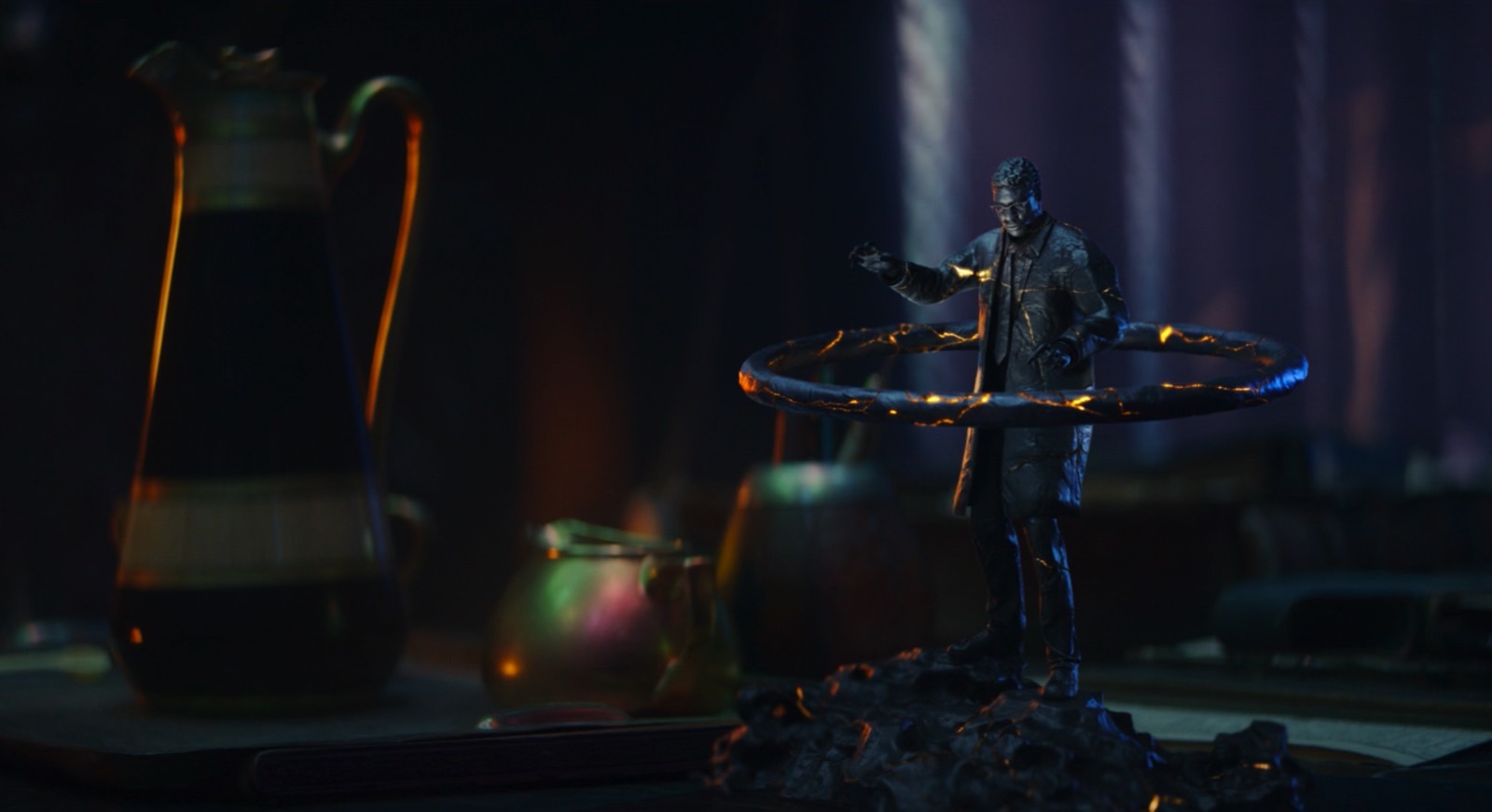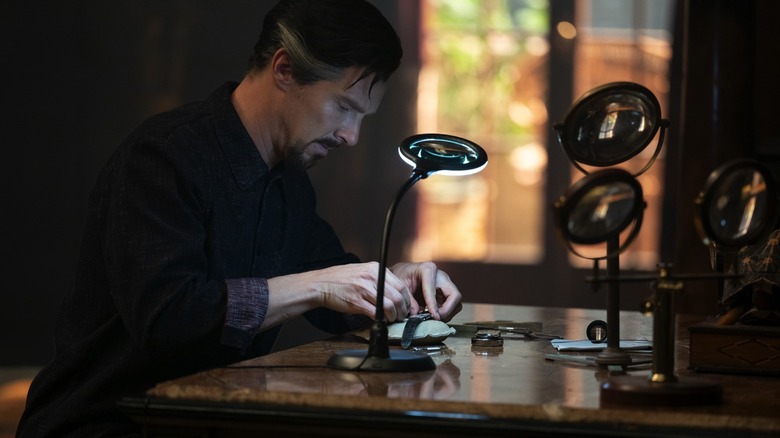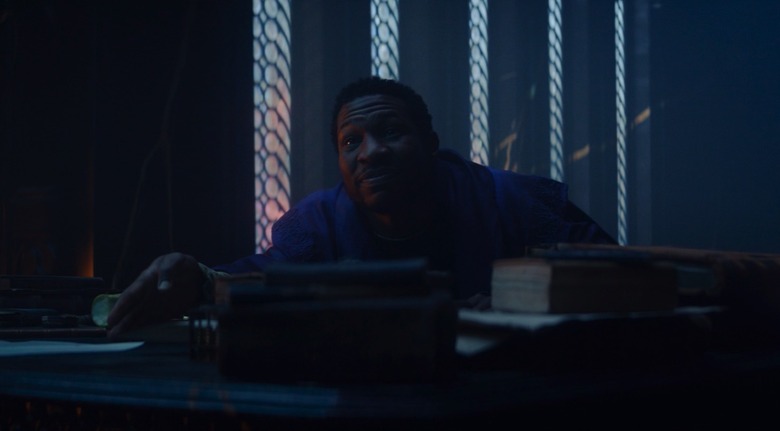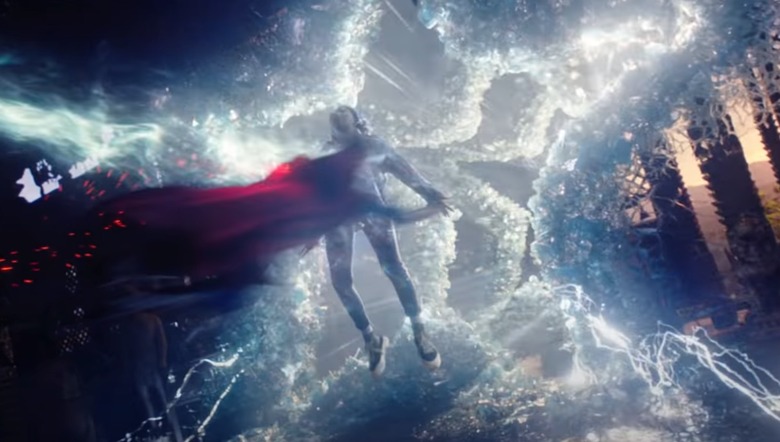How Doctor Strange 2 And Kang's Death In Loki Are Connected
Doctor Strange in the Multiverse of Madness is $12 million shy of $700 million after two weekends at the box office, despite a significant drop off in the second weekend. The movie seems set to surpass $1 billion in the coming weeks, cementing Doctor Strange as a character that can draw a crowd. But Multiverse of Madness isn't just continuing the character arcs of Strange and Wanda. It also sets the stage for an important event in the MCU called incursions, something the movie spends little time explaining. To actually understand all of that, you need to be aware of the links between Loki and Doctor Strange 2, including the death of the MCU's first Kang variant.
The death of He Who Remains (Jonathan Majors), which is what this Kang variant introduces himself in Loki, made possible the multiverse events that we've witnessed ever since. No Way Home and Multiverse of Madness are just two consequences, but the ripples might be more significant. The MCU timeline is more complicated when it comes to Kang. That's why it's critical to correctly understand what happened in the Loki finale to have a better grasp of the MCU continuity.
Before we can explain, you should know that MCU Phase 4 spoilers will follow below.
Before we get to the links between Loki and Doctor Strange 2, we must understand the most important thing that happens in the Loki finale.
Kang's first MCU death happens out of the regular flow of time. Loki (Tom Hiddleston), Sylvie (Sophia Di Martino), the TVA, and Kang do not experience time flow as each universe does. The finale, in particular, happens outside of time. It's not inside a universe that flows from point A to point B. It's in a static place with an overview of all time, forever.

Kang’s death happens right now
Therefore, there's no correct way to set Kang's death in the MCU chronology. Because Kang dies (and lives) perpetually in that place. From our point of view, Kang's death happens right now. It happened a second ago, and it will happen a second from now. Kang dies with each letter I type. And he dies with each word you read. It's relentless. It's simultaneous with the past, present, and future. Always and forever.
Similarly, Kang lives perpetually compared to our vantage point. The Loki finale also takes place perpetually. And it's simultaneous with everything in the Sacred Timeline. Or in the MCU timeline.
That's why we can't simply insert Kang's death before No Way Home or before Multiverse of Madness. Kang's death at the hands of Sylvie happens simultaneously with everything that occurs in a linear timeline. It wasn't when the TVA removed Loki to prevent a branch from forming. Or during the 2023 events of Endgame. And it's not in 2024 or 2025, right before No Way Home or Doctor Strange 2.
Kang dies as Tony Stark (Robert Downey Jr.) builds his first Iron Man suit. He dies when Captain America (Chris Evans) becomes the first Avenger. When Black Widow (Scarlett Johansson) completes the mission that allows her to switch sides to SHIELD. When Doctor Strange (Benedict Cumberbatch) loses his hands. Kang dies as the Avengers beat Thanos. But he's also alive to witness all of these events if he wants to.
How Kang controls everything
Kang is not living just at the end of time, but at the beginning and the middle of it. From his vantage point, he can see everything in the universe and intervene to control the timeline and ensure the worst versions of him do not appear.
The simplest analogy for Kang's perspective is watching TV, with a few differences. You can watch any channel for as long as you want, and you can change what happens on the screen in real time without anyone involved in those TV shows knowing what's happening.
You can watch as many channels as you want — in this case, timelines. And time doesn't pass at all while you do. You have time to watch all the TV you want.
So while Kang is both dead and alive when the events in Doctor Strange 2 happen, he stopped watching the universe at some point. That was the only way to give Loki and Sylvie free will. They could continue his work or kill him.
As a result, while Kang's death happens simultaneously with everything in the primary MCU reality, including Doctor Strange 2, he hasn't necessarily seen everything. Because he chooses not to do it.
Why Kang's death matters for Doctor Strange 2
That's a very important detail which we've partly explained. The events in Avengers: Infinity War and Endgame happen in that particular order because Kang wills it so. That means the TVA pruned the abnormal branches according to Kang's wishes.
The events in No Way Home and Doctor Strange 2 wouldn't be possible in a timeline that Kang would closely manage. He wouldn't let the multiverse get out of whack because Spider-Man (Tom Holland) felt the need to make the world forget him. Kang might also interfere with Wanda (Elizabeth Olsen) and prevent her from descending into madness.
In turn, this would prevent Stephen's journey into the multiverse. Or the MCU reality getting a superhero that can travel the multiverse at will. That also means Clea (Charlize Theron) would not show up, as there would be no incursion to worry about.
And incursion sounds like an unnecessarily polite term to describe a multiversal war that Kang wanted to prevent in the first place. Put differently, Kang's death leads to multiversal wars instantly, from his perspective.
With all that in mind, I realized we have to stop asking what year Kang died. Because, as I've just explained, Kang's death is contemporary with everything happening in the universe. We're now witnessing/suffering the consequences. It's only a few years after Endgame from our perspective.
The Loki finale shows the MCU timeline growing branches everywhere at the same time as Sylvie kills Kang. That's the moment he doesn't control time anymore. The moment when the TVA stops pruning those branches.
Is Earth-616 in Doctor Strange 2 the Sacred Timeline or just a branch of it?
The moment Kang died, the MCU's primary reality was set free. And we've only come to witness some of those unscripted events that followed instantaneously. Again, Kang could always see each and every one of them unfold. Even the events in Doctor Strange 2. But he just stopped looking at it to face Loki and Sylvie.
Those branches appear everywhere on the timeline, not just in the MCU future that we're now getting to experience. We also have branches in the past and present. And they all appear simultaneously.
Earth-616 might not even be the Sacred Timeline that Kang curated for so long. It could be a branch in it that the TVA never pruned. It could have started with Peter Parker in No Way Home. Or with Wanda in WandaVision when she left with that Darkhold book. Or with one of Doctor Strange's many arrogant replies or spells. We just don't know. And we might never have to get a precise moment when Kang's death interrupted the regular programming of the Sacred Timeline. What we know is that Earth-616 is the MCU's primary timeline.
Also, we speculated that Steve Rogers' decision to retire in a different reality is possible because Kang died. That's in the late '40s from that universe's perspective. But since everything in the universe happens all at once, that moment can coincide with other pivotal moments in the MCU that set us to the path to Secret Wars. Because that's what Doctor Strange 2 does. It sets the stage for the kind of big multiverse mess that the better version of Kang wanted to avoid.
More Marvel coverage: For more MCU news, visit our Marvel guide.



